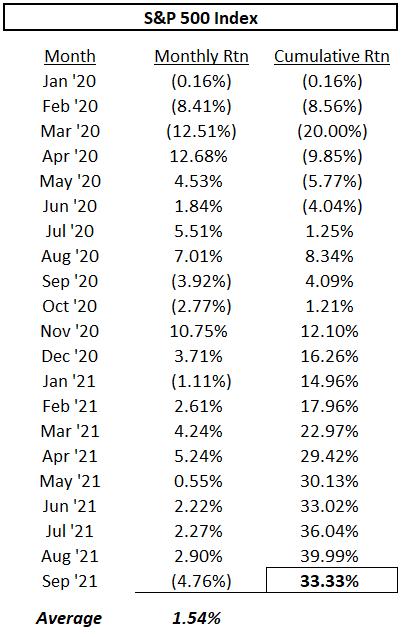
Investing successfully for the long term requires a balance between give and take, choosing the pros and the cons of different investment approaches, taking the good with the bad, and accepting the risks with the rewards of investing. In other words, you can't have it both ways. You can't have your cake and eat it too; you will have to make some tradeoffs between what you want and what you need. Some investors expect to have all of the good without any of the bad, to get the rewards but not take the risks, to participate in all the upside and avoid all the downside. That is not possible and never will be. Chasing investments or investment strategies that promise the reward without the risk is foolish and will always lead to disappointment. It is much better for you to make an honest assessment of what tradeoffs you can tolerate and invest accordingly.
If you are the type of investor that likes to have your investment accounts at all-time highs whenever the market is making all-time highs, you should probably just be a passive index fund investor. You can do this with low-to-no-cost ETFs that give you exposure to the same market indices discussed on the financial news networks every day. When the news proclaims the market is at all-time highs, if all of your money is in an S&P 500 index ETF, then you will feel great that your account is also at all-time highs. Of course, when the S&P 500 is in a bear market, your account will be too.
It is important to realize, though, that choosing to be a passive investor tied to a particular index doesn't free you from having to make tradeoffs with your investments – you are still accepting the good and bad of passive investing and making a tradeoff with all the other ways one could invest. The "good" is the long-term returns of the index, the strong bull market periods, never underperforming the market, and having your account at all-time highs when CNBC is lauding the market highs. The "bad" is that you will never beat the market, you'll have high volatility, you'll have periods of sheer terror when massive drawdowns occur during bear markets, and there will be long periods of time spent just recovering losses after a bear market has bottomed with a drawdown of 30%, 40%, or 50%.
If you want the "good" listed above, you have to be willing to accept the "bad" too. You can't have one without the other.
People often choose to invest differently from a passive, index-based portfolio, in hopes of having their allocation change drive some outperformance to the market. It takes effort to do things differently, so unless there is an expected benefit, why else would one attempt it? The reasons could be numerous, but at the end of the day, if you do anything different than passive index investing, you are implicitly (or explicitly, for some) making tradeoffs in these good and bad aspects to investing. You are changing what risks you are willing to accept for the returns you seek.
If you are an investor with a typical benchmark 60% stock (SPY) and 40% bond (AGG) allocation, you have many portfolio-construction levers to pull (i.e., tradeoffs to make) in your effort to "beat the market". You may stay passive and chose to incorporate allocations to other index ETFs, such as the Nasdaq Composite or to the Russell 2000, because you think they'll outperform the large-cap stocks of the S&P 500. That outperformance could come from larger upside returns or smaller downside returns. Some tradeoffs you just made are that you may not be at all-time highs at the same time as the S&P 500 but you may have lower volatility because your portfolio is more diversified. You could also change your bond allocation away from AGG by incorporating longer- or shorter-duration bonds, or higher or lower credit quality, etc. These are all tradeoffs you are making with the "free and easy" benchmark portfolio, and you should be aware of them and why you are willing to make them.
Maybe instead of passive investing you move to a more active strategy that involves stock picking, like trying to invest in a subset of S&P 500 stocks that will outperform the index. Stocks could be selected based on fundamental analysis, technical setups, or factor-based screening. You are still trading benchmark performance, with its specific risk and reward profile, for a different investment approach that may or may not have better returns or risks. One should assess if the new risk and reward profile is desirable and justifies the difference from the benchmark. One also should understand the tradeoffs made and if they are acceptable – i.e., if the difference from the benchmark is tolerable by the investor.
We think it is very important to have a good understanding of why you may want to be invested differently and the tradeoffs that are being made with the different allocation. Knowing and understanding how and why your portfolio will behave differently than the benchmarks is key to having the discipline often required to stick with something that is different.
We choose to invest differently because we know that the "bad" that comes with passive investing is just not acceptable to the vast majority of investors. We primarily manage strategies that are rules-based and 100% tactical. This means that we can move from being 100% invested in the stock market to being 0% invested in the stock market (100% defensive) based on the rules of our tactical ETF strategies. Why do we choose to manage money this way? For two main reasons: (1) the math of compounded returns, and (2) we believe it is what clients NEED, whether they recognize it or not.
#1, The Math of Compounded Returns
Let's use a real-world example to illustrate. The US stock market had its first bear market in more than 11 years during 2020, due to the global pandemic. Here are the monthly returns of the S&P 500 since 2020, and the average and cumulative compounded returns during these years.

The S&P 500 has an average return each month of 1.54%, while the cumulative compounded return over this time period is 33.33%.
As mentioned in previous articles, our trend following strategy did very well at getting out of the way of the COVID bear market and avoided all of the drawdown that occurred during the first half of 2020.
Trend has an average return each month of 1.50%, while the cumulative compounded return over this time period is 34.45%.
Trend had a smaller average monthly return than the S&P 500 but the compounded return on trend following is greater – and compounded returns are what matter to investors. This result is what we mean by the "math of compounded returns." If you can avoid large negative months (or quarters, or years), your returns can compound at a higher rate over time since large negative numbers destroy compounding – it's just math. Same as the trend-following truism that says, if you are able to miss most of the bad times, you don't have to participate as much on the upside to still come out ahead.
#2, What Clients Need
For reason #2, we have found that most clients cannot tolerate large drawdowns. They NEED an investment approach that focuses on risk management rather then what they say they WANT, which is typically to achieve outsized returns. Most investors cannot successfully ride the bear market down 33.9% (like we saw the S&P 500 drop in 2020) and continue to hold onto their position until the market fully recovers. In theory, this type of investor must exist (academic finance is entirely based on their existence), but in practice, we never find them. The losses in bear markets are far too great to withstand. This is especially true for investors that are nearing retirement or already retired. Bear market losses can completely devastate your retirement plans when time isn't on your side to wait for a recovery. Thus, clients NEED risk management and a way to avoid the devastation of bear markets, while still getting "good" returns during bull markets.
Over the same months shown in the tables above, when the S&P 500 suffered the 33.9% drawdown, the trend strategy maximum drawdown was only 10.7%. This happened in October 2020 just after the S&P 500 had fully recovered from the bear market (notably, our drawdowns occur at different times than the market's). We firmly believe that drawdown is the best measure of risk (as discussed in previous articles), and so our trend strategy was able to deliver higher compounded returns over this time period while taking significantly lower risk – that is why we invest differently.
There is no such thing as an investment strategy that gets it right all the time or has all the good without any bad. People always look for the holy grail of investing, something that provides the upside returns of the S&P 500 and somehow avoids the downside. It doesn't exist. What can exist is an acceptance of which risks and "bad" results you can tolerate, then find the strategy that provides the best returns based on accepting those risks.
The tradeoffs we make to manage money through our tactical strategies are numerous, and we have to fully accept the "bad" aspects of our approach. We suffer whipsaw trades and often underperform the benchmark portfolios, we frequently are not at new highs in our strategy when the market is making all-time highs, we have down days and months when the market is up, etc., etc. We are willing to make all of these tradeoffs in order to achieve the results that we and our clients NEED, even if it's not always what we WANT.
Dance with the Trend,
Greg Morris






